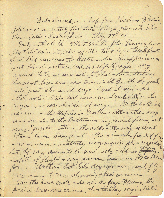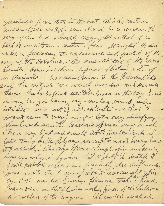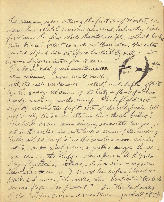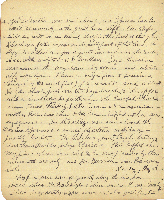[page 25] Birds observed on a trip from Shoshone Station, Idaho-across twenty five miles of sage plains to Shoshone falls. Snake River -May 27-99.
Early in the A.M.-5: to 5:30-Mr. John Burroughs & I left the train to take up the time before breakfast. first bird seen was the western robin-in appearance just like the eastern bird, but slightly larger-song seemed to be as were all its other notes-identical. The next birds seen were Brewer's bl. B. with the "jook" note: just like a red-wings-heard it make no other note. This bird was seen abundantly in the canyons, as was also the red-wing. Bullock's Oriole was seen in the Maples in Shoshone village-their song was similar to the Baltimore's in general form, but was more "jugular", both in the calls & the song & about 3 tones lower throughout. The crimson fronted finch was common - instantly recognizable for a carpodacus but the song seems to be more reedy-not so clear. Habits of flight & song seemed same as the eastern form. Western Red tails very common, and fly very near to one showing little concern.
On the horse-back ride over the sage-plains, the prairie-larks were common, their tinkling song indistin [page 26]guishable from that in the east. Also the Western meadow lark was to be seen & heard in numbers. The song of this bird is hardly recognizable as that of a bird so close to our Eastern form. It might be described as possessing the exuberance and quality of the song of the Bobolink-the romantic tone of the wood thrush-done in clear, piping or fluting notes of a sturnella. No resemblance to the Florida bird's song. The call notes are entirely new also-can't describe them. The lark-finch was to be heard in the sage brush its song being a canary song-very long, varied and intricate-in a sort of rich contralto-so that it doesn't seem to carry very far, but is very satisfying when heard near to. Brewer's Sparrow sings much like a very light and small West. Meadow lark. I take this from Mr. Ridgeway's description, not having heard it positively. The sage sparrow (Amphispiza nevadensis) was seen & heard by some but I failed to identify it. Jack Rabbits were seen frequently, also chipmunks, praire rats etc. A young rabbit was caught alive by Cole - ass. biol. Survey. Homed toads & small lizards were seen on the plains-other kinds of the latter in the rocks of the canyon. When we reached the canyon, [Page 27] upon entering the first ampitheatre we saw immediately several new and interesting birds. first were the five white throated swifts-which looked like bl. & wh. velvet, so rich was their color. The notes sounded at first like the Sparrowhawk's "Killy Killy"-but became differentiated from it soon. The lovely violet green swallows were very common & are most ravishing with the rich irridescence-velvety in its depth, offset by the snowy whiteness of the belly & flank patelies nearly meeting over the rump. Their flight note slightly recalls the flight notes of the gold finch, but not really the same-between this & the wh. bellied S. The rock wren came singing across the canyon & lit in the rocks-his note was a series of descending trills, not so "limpid" as the carolinas similar notes, nor comprising so great range. A raven was seen by the bluffs-also a pair of W.R. Tails. Say's flycather -whose note is a clear & vigorous cleweee [illus.] showed his rufous breast & black tail among the rocks, also 'verticalis' the Arkansas flyc. was present. In the lowlands of the upper canyon a vireo (Merriam) a chat (l.T) & [page 28]yellow warbler were seen or heard, and Sparrowhawks most commonly in the great lava cliffs. An osprey built his next on an island bluff in the head of the great Shoshone falls & was on its nest part of the time. The cliff swallow was found quite common in the rocks, in es. with swifts &., Sage thrashers were seen on the way home by some-and about half way home I saw a magnificent Louisiana tanager-(Coe saw it first) fly across the road a short 30 yds. ahead just over the sage brush, & disappear in it a hundred yds farther on. Wh. Rumped Shrikes seen twice. Turkey vultures were not uncommon, & another raven was seen. & Mr. Swain Gifford & others saw sage grouse. In the village were seen & heard Wh. crowned sparrows & a small flycatcher-Empidonax-possibly Wrights. Mr. Ridgeway saw a Lazuli bunting, Audubon's Warbler, & Sage Sparrows. Mr. Gifford saw Magpies-where were said to be conspicuous by their unwonted scarcity, and Dr. Meriam saw Burrowing Owls.

[page 25]

[page 26]

[page 27]

[page 28]